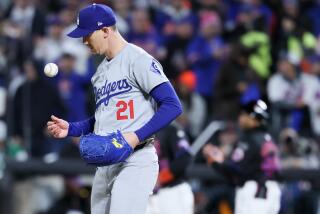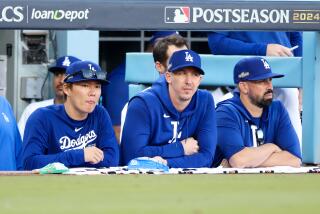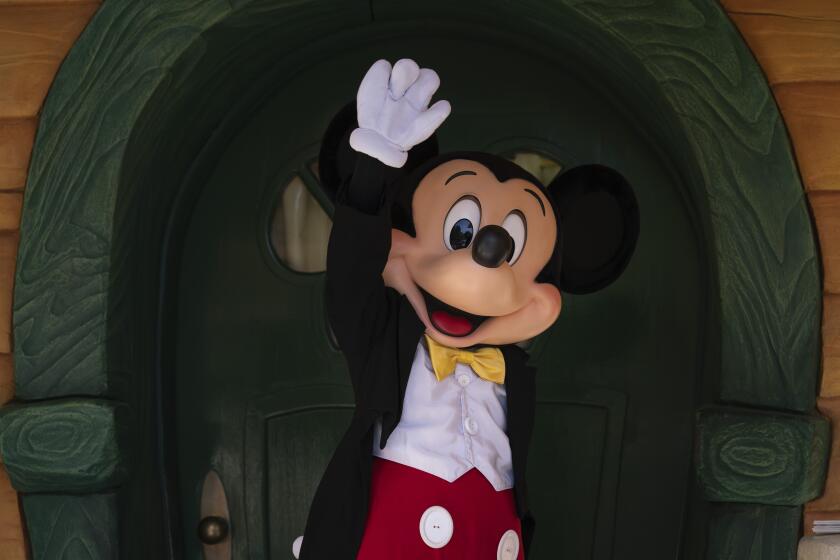Voyeurism and Ghostly Visions From Paul Pfeiffer
- Share via
Paul Pfeiffer makes video art that, at its best, exploits the one-to-one relationship between viewer and image more commonly found in the experience of painting than of most video. The resulting intimacy can be disarming.
At the Project, the New York-based artist has his L.A. debut with a show of three video works, two sculptures and a photograph, including a work related to the one that gained him instant notoriety at the 2000 Whitney Biennial. “Three Studies for Figures at the Base of a Crucifixion” (2001), like the Francis Bacon painting to which the title refers, is a video triptych that uses art of the past as a springboard for up-to-the-minute meditations on current social obsessions.
The triptych is made from three miniature video projectors affixed to the wall on short armatures. The side-by-side projected images are tiny (just 4 by 6 inches), requiring that you stand close and peer into them.
What you see is a short, repeating loop showing a familiar modern spectacle--a pro basketball game in a huge stadium, witnessed from the court-level closeness of network TV. The image on the wall is writ small and with concentrated intensity, like an electronic manuscript illumination.
The crowd-filled bleachers are a silently roaring blur and flashbulbs pop like a summer meteor shower, but there isn’t a basketball player in sight. Pfeiffer has digitally erased the men, who leave ghost-images in the rippling electronic ether. All that’s clearly seen is the basketball careening through space, back and forth. It’s like essence-of-thrill, pure sensation weirdly abstracted.
“Sex Machine,” a second, single-image work with a similar format, shows a short loop of a pop singer on stage in close-up and in mid-croon. His facial features have been digitally erased. In any event he’s largely obscured by the chunky microphone, which he caresses with both hands. They’re clasped around its girth in a manner at once erotic and prayerful (Francis Bacon again). The muffled soundtrack repeats a breathy gasp.
Pfeiffer’s video erotics assume monumental scale yet more subtle resonance in “Dutch Interior.” The wall-size projection shows a view down a staircase toward a tastefully appointed, middle-class foyer in a domestic environment. Nothing moves, except for the enlarged fuzz of the video scan lines.
Eventually you notice a bright, glowing spot low on the wall; when approached, it turns out to be a peephole. Peer inside and you see a dollhouse interior--the same foyer and staircase that’s in the live feedback image, but this time seen from below. Suddenly you feel as if the hidden camera is spying on you.
Voyeurism and a distinctly modern sense of ghostly, ethereal presence are Pfeiffer’s stock in trade. Sometimes the sensation doesn’t cohere, however, as in another Pfeiffer work currently on view at the UCLA/Hammer Museum. A disappointment at this year’s Venice Biennale, “Self-Portrait as a Fountain” applies the title of a famous Bruce Nauman photograph to an installation work. It features a larger-than-life bathtub and tiled shower, obviously adapted from the most famous scene in Hitchcock’s “Psycho,” while video cameras on booms are stationed around the over-scaled stage set. A nearby monitor cycles through a sequence of images: shower curtain head-on, view up into the streaming shower head, close-up of water running into the drain. The gimmicky installation is as blandly involving as a diagram.
Also weak is a second Hammer video piece, which shows the heads of furiously running basketball players held stationary in the center of a tiny screen. (The screen is mounted at the end of a long pole raised some seven feet above the floor--basketball-player height.) The background is a whirling blur, while the stationary heads morph seamlessly into one another at a steady clip--black, white, male, female. It’s all rather like an old Michael Jackson video.
Pfeiffer, 35, is an erratic artist, by turns invigorating and enervating. Sometimes the textured thrill of pure sensation gives way to the tedium of pure corn.
The Project, 962 E. 4th St. (enter on Hewitt), Los Angeles, (213)620-0692, through Nov. 17; closed Sunday through Tuesday. UCLA/Hammer Museum, 10899 Wilshire Blvd., Westwood, (310) 443-7000, through Oct. 28; closed Monday.
*
Zoom Lenses: Darcy Huebler returns after a three-year hiatus with eight new abstract paintings that are fresh, visually eccentric and intellectually compelling. They remake traditional stripe paintings into something multidimensional and strangely cinematic.
The show at ACME includes six single-panel paintings and two diptychs. Huebler raids fashion for her acrylic palette, with matte, light-absorbent colors that include tropical orange, sea breeze blue, lemon-lime and sage, along with navy, crimson, black and white.
The painted stripes don’t just lay flat on the surface. Instead, she wraps them around the edges of each two-inch-deep wooden panel, as if it were an upholstered object.
Each vertical stripe is banded by white stripes, and they bend, swell and bow to the right and left. A stripe is a line, but here the line is also a shape. Furthermore the shape, as in an Ellsworth Kelly painting, is indistinguishable from an uninflected field of color. Traditional painterly distinctions between line and shape and between line and color dissolve.
Huebler also gets an element of visual movement going from the rhythmic repetitions of bowed shapes. In the two diptychs, she ratchets up the swinging pace.
“This Side/That Side” is composed of two panels of equal size (60 inches by 48 inches), while the pattern of the stripes in each is similar yet different. Your eye, which scans back and forth comparing patterns, is further propelled by the bowed shapes, as if launched by an optical slingshot.
“Real to Real” is a diptych with identical patterns on each side. Here, however, the dimensions of the panel on the left are twice as large as those of the panel on the right. Optically these panels push forward and backward in space, transforming your eye into something like a zoom lens.
ACME, 6150 Wilshire Blvd., L.A., (323) 857-5942, through Saturday.
*
Poetic Arte Povera: A handsome, carefully chosen selection of sculpture and drawings at Christopher Grimes Gallery shows San Francisco artist David Ireland at his best. The 10 sculptures date from the past dozen years, while most of the 40 small paintings on paper were made in the last two. In all of them, material objects assume an elusive poetry.
The sculptures typically employ the detritus of urban society, such as cast-off furniture, enameled pans, lumps of concrete and tangles of thick wire. Ireland pairs them with pure pigments in primary colors--red, yellow and blue.
The result is an American version of Italian Arte Povera (“poor art”), an alchemical transformation of fragile trash into more fragile treasure.
In one, a metal plate painted red is caught in a tangle of wire suspended from the wall. In another, a piece of cloth soaks up fluid yellow pigment through capillary action, which leaves a crystalline residue at the bottom of a beat-up old pan. In a third, a tipped-up sink topped with a towel-shrouded mirror feels oddly anthropomorphic, as if the sink drain were a belly button and the partially covered mirror an inscrutable face.
Ireland’s abstract works on paper, most of them unceremoniously pinned to the surrounding walls in the small gallery at the rear, use paint that seems to reveal through the act of concealing. Tan is loosely brushed over black, blood red over beige, beige over white over red; the layers are glimpsed at the margins. Some include skeletal, architectonic drawing (reminiscent of Diebenkorn), which functions as a kind of scaffold. Ireland’s work is like that: a platform located somewhere above the material plane of mundane existence but firmly connected to it.
Christopher Grimes Gallery, 916 Colorado Ave., Santa Monica, (310)587-3373, through Oct. 13. Closed Sunday and Monday.
*
Snow and Static: Imagine the risk: Hold a raffle open to anyone, whose prize is a solo exhibition at a gallery. See the result: “Static,” an accomplished, thoroughly professional, finally unexceptional show of paintings by Reed McMillen at INMO Gallery.
LA Weekly art critic Doug Harvey concocted the raffle idea, which was born of a belief that a lot more artists worth showing are at work than there are gallery exhibition slots available. It could have been a fiasco. That it’s not is a testament to the high level that mid-range art now occupies.
McMillen’s spray paintings appear abstract but aren’t: They approximate the look of snow and static on television screens that are out of whack. Fuzzed patterns undulate and interweave in complex optical riffs.
McMillen sets them off by pushing the panels forward on beveled supports (think of a painting attached to the front of a picture frame rather than the back). The hidden bevel is painted fluorescent orange, a color that reflects off the white gallery wall and makes the painting seem to hover in chromatic space. The result is a wry painterly meditation on the seductive evanescence of video.
INMO Gallery, 971 Chung King Road, Chinatown, (213) 626-4225, through Saturday.
More to Read
The biggest entertainment stories
Get our big stories about Hollywood, film, television, music, arts, culture and more right in your inbox as soon as they publish.
You may occasionally receive promotional content from the Los Angeles Times.











